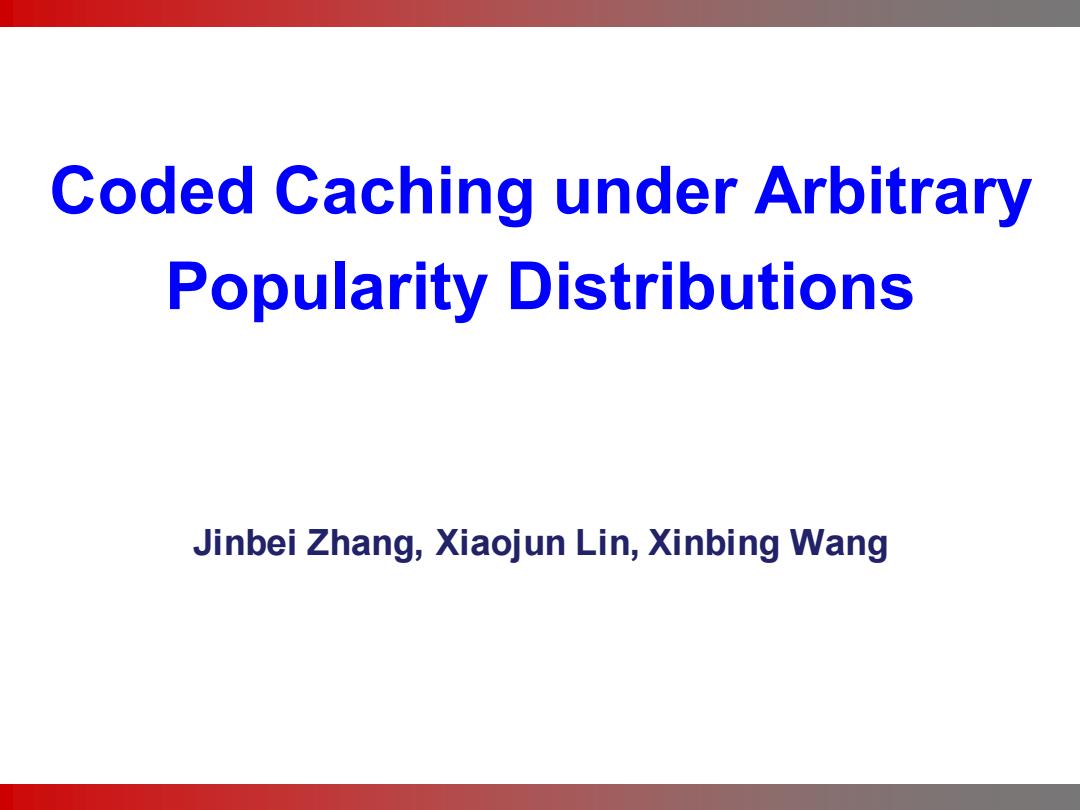
Coded Caching under Arbitrary Popularity Distributions Jinbei Zhang,Xiaojun Lin,Xinbing Wang
Coded Caching under Arbitrary Popularity Distributions Jinbei Zhang, Xiaojun Lin, Xinbing Wang
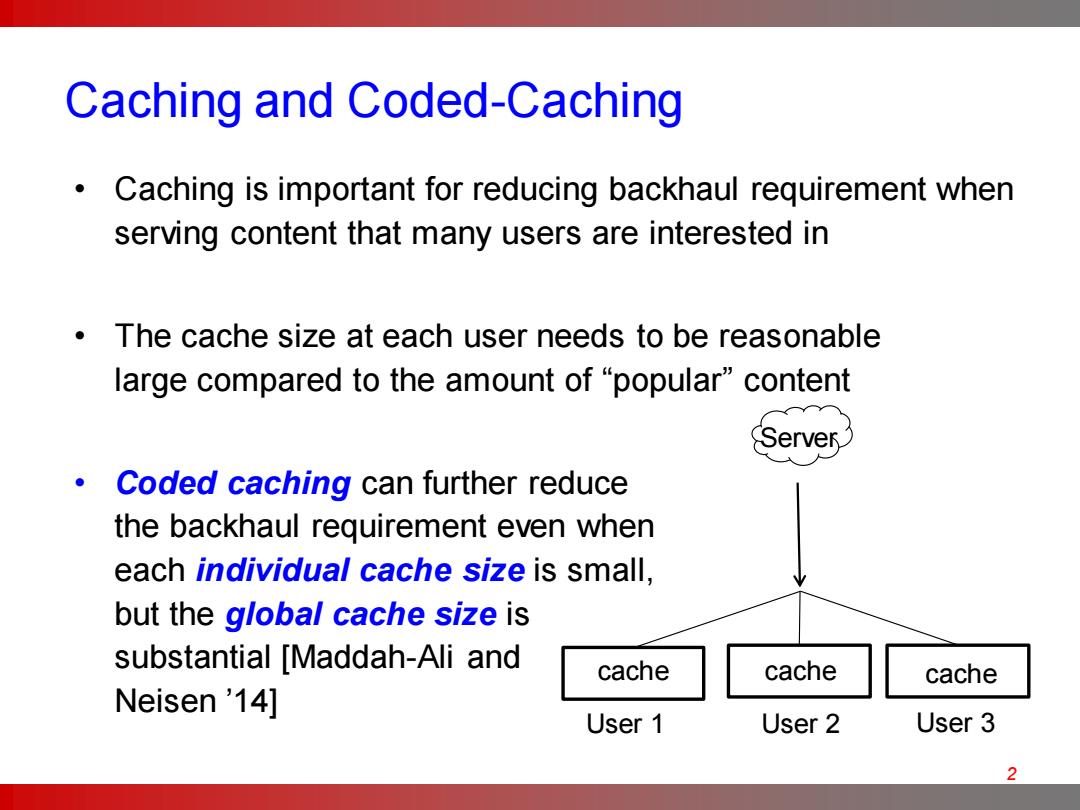
Caching and Coded-Caching Caching is important for reducing backhaul requirement when serving content that many users are interested in The cache size at each user needs to be reasonable large compared to the amount of "popular"content Server Coded caching can further reduce the backhaul requirement even when each individual cache size is small, but the global cache size is substantial [Maddah-Ali and cache cache cache Neisen '14] User 1 User 2 User 3 2
Caching and Coded-Caching 2 Server cache cache cache User 1 User 2 User 3 • Caching is important for reducing backhaul requirement when serving content that many users are interested in • The cache size at each user needs to be reasonable large compared to the amount of “popular” content • Coded caching can further reduce the backhaul requirement even when each individual cache size is small, but the global cache size is substantial [Maddah-Ali and Neisen ’14]
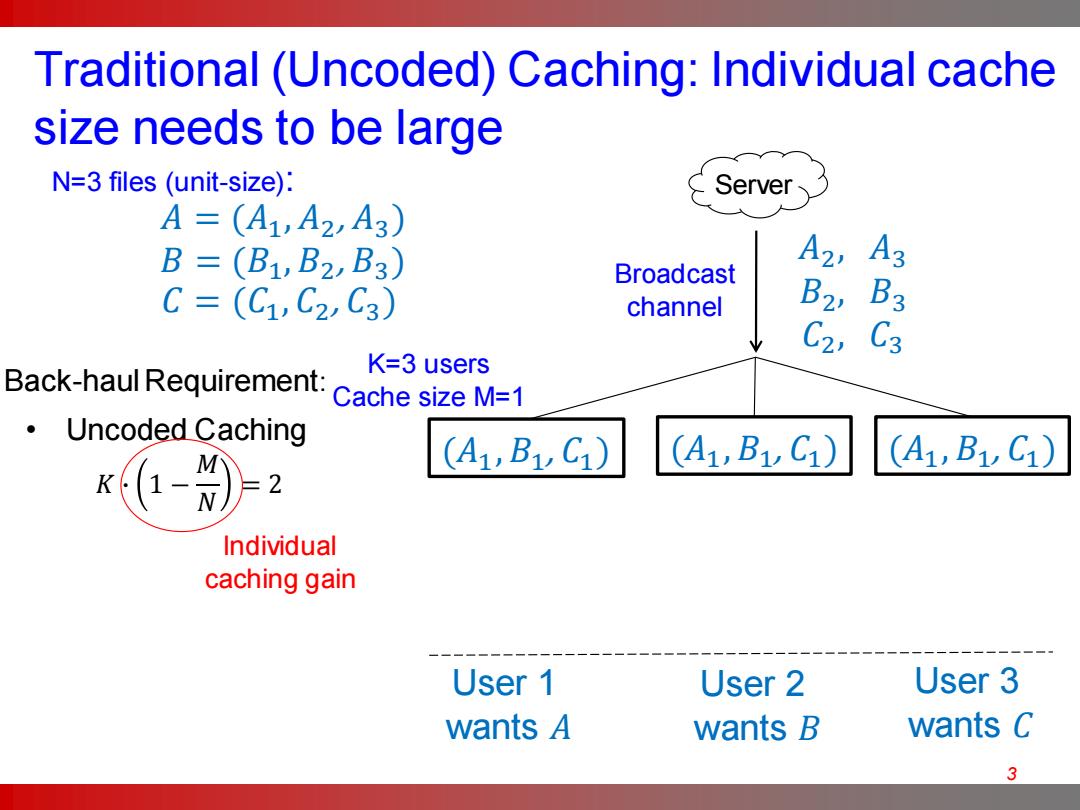
Traditional (Uncoded)Caching:Individual cache size needs to be large N=3 files (unit-size): Server A=(A1,A2A3) B=(B1,B2,B3) A2 A3 Broadcast C=(C1,C2,C3) channel , B3 C2, 3 K=3 users Back-haul Requirement:Cache size M=1 Uncoded Caching (A1,B1C1) (A1,B1C1) (A1,B1C1) Individual caching gain User 1 User 2 User 3 wants A wants B wants C 3
3 (𝐴1 , 𝐵1 , 𝐶1 ) User 1 wants 𝐴 User 2 wants 𝐵 User 3 wants 𝐶 Traditional (Uncoded) Caching: Individual cache size needs to be large Server K=3 users Cache size M=1 Broadcast channel 𝐴 = (𝐴1 , 𝐴2 , 𝐴3 ) 𝐵 = (𝐵1 , 𝐵2 , 𝐵3 ) 𝐶 = (𝐶1 , 𝐶2 , 𝐶3 ) N=3 files (unit-size): • Uncoded Caching 𝐾 ∙ 1 − 𝑀 𝑁 = 2 Back-haul Requirement: (𝐴1 , 𝐵1 , 𝐶1 ) (𝐴1 , 𝐵1 , 𝐶1 ) 𝐴2 , 𝐴3 𝐵2 , 𝐵3 𝐶2 , 𝐶3 Individual caching gain
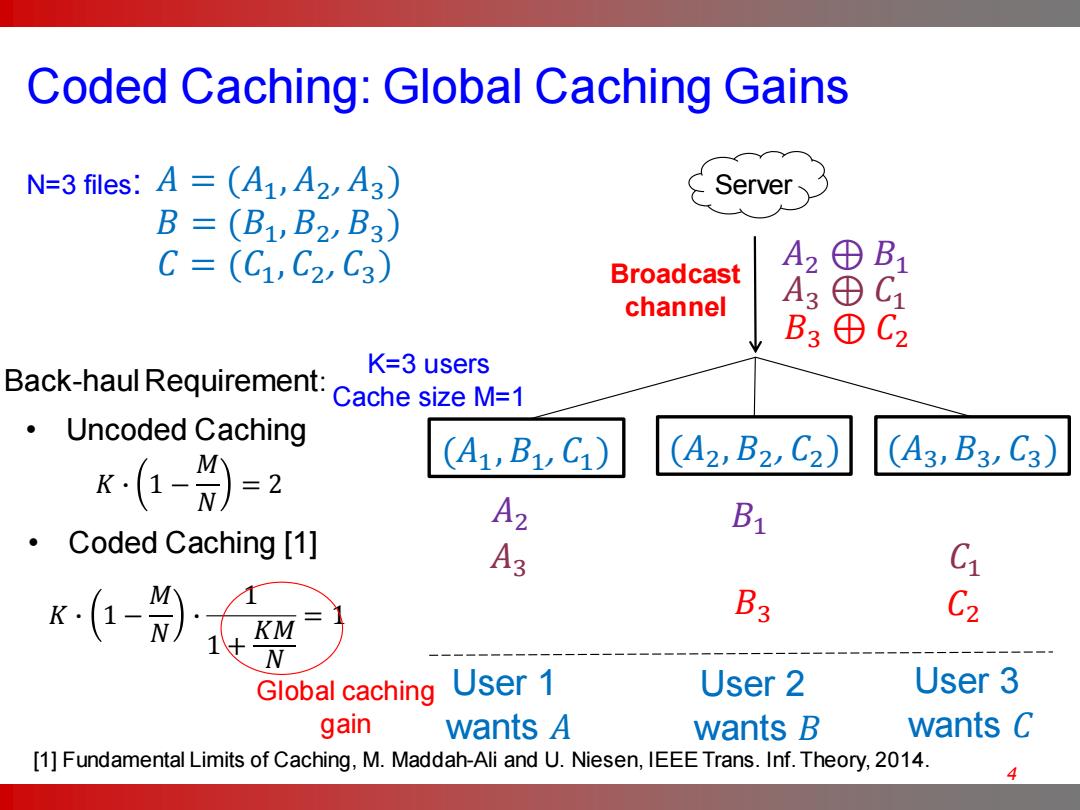
Coded Caching:Global Caching Gains N=3 files:A=(A1,A2,A3) Server B=(B1,B2B3) C=(C1,C2,C3) Broadcast A2 ⊕ channel B3 中 BG2 K=3 users Back-haul Requirement:Cache size M=1 Uncoded Caching K(1-9)=2 (A1,B1C1) (A2,B2,C2) (A3,B3C3) Bi Coded Caching [1] A3 B3 C2 Global caching User 1 User 2 User 3 gain wants A wants B wants C [1]Fundamental Limits of Caching,M.Maddah-Ali and U.Niesen,IEEE Trans.Inf.Theory,2014. 4
4 (𝐴1 , 𝐵1 , 𝐶1 ) (𝐴2 , 𝐵2 , 𝐶2 ) (𝐴3 , 𝐵3 , 𝐶3 ) 𝐴2 ⊕ 𝐵1 𝐴2 𝐵1 𝐴3 ⊕ 𝐶1 𝐴3 𝐶1 𝐵3 ⊕ 𝐶2 𝐵3 𝐶2 User 1 wants 𝐴 User 2 wants 𝐵 User 3 wants 𝐶 Coded Caching: Global Caching Gains Server 𝐾 ∙ 1 − 𝑀 𝑁 ∙ 1 1 + 𝐾𝑀 𝑁 = 1 • Coded Caching [1] [1] Fundamental Limits of Caching, M. Maddah-Ali and U. Niesen, IEEE Trans. Inf. Theory, 2014. K=3 users Cache size M=1 Broadcast channel 𝐴 = (𝐴1 , 𝐴2 , 𝐴3 ) 𝐵 = (𝐵1 , 𝐵2 , 𝐵3 ) 𝐶 = (𝐶1 , 𝐶2 , 𝐶3 ) N=3 files: Global caching gain • Uncoded Caching 𝐾 ∙ 1 − 𝑀 𝑁 = 2 Back-haul Requirement:
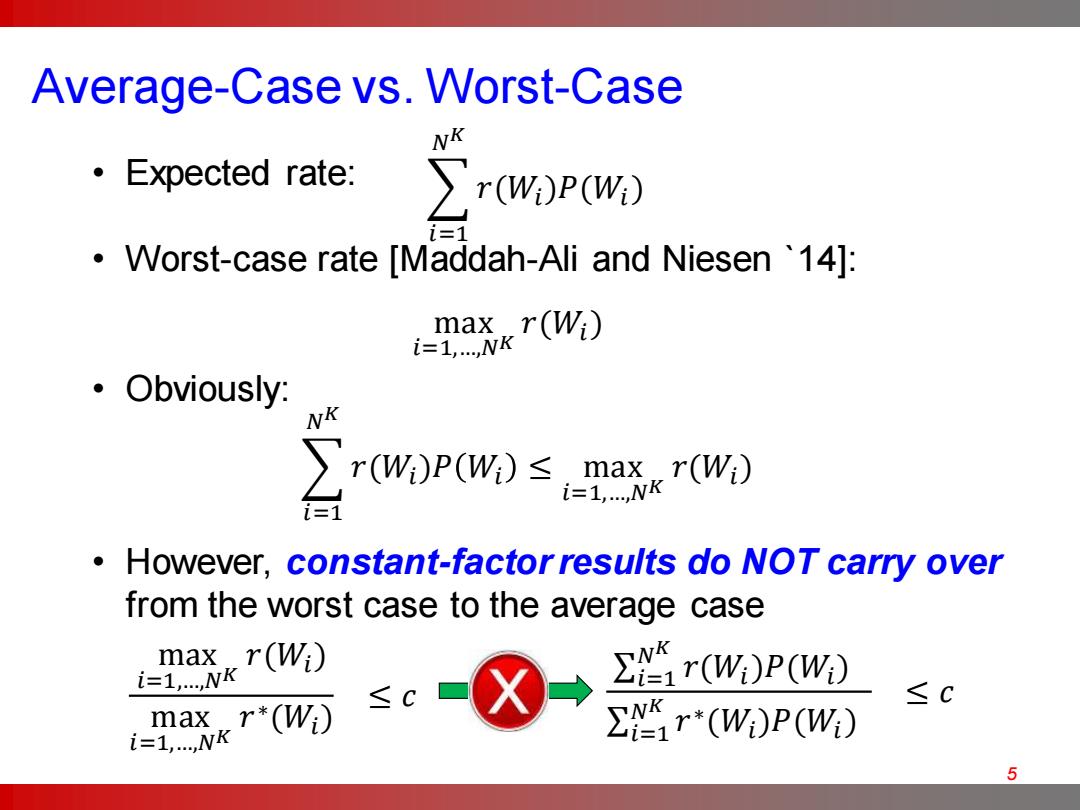
Average-Case vs.Worst-Case NK ·Expected rate: r(Wi)P(Wi) i=1 Worst-case rate [Maddah-Ali and Niesen '14]: max r(Wi) i=1,...NK ·Obviously: NK r(W)P(W)≤ max.r(Wi) i=1,...NK i=1 However,constant-factorresults do NOT carry over from the worst case to the average case max r(Wi) i=1,....NK r(W:)P(W) ≤C maxr*(Wi) ≤c-X→ i=1,...NK Σr*(W)P(W) 5
Average-Case vs. Worst-Case 5 • Expected rate: • Worst-case rate [Maddah-Ali and Niesen `14]: • Obviously: • However, constant-factor results do NOT carry over from the worst case to the average case 𝑖=1 𝑁 𝐾 𝑟(𝑊𝑖)𝑃(𝑊𝑖) max 𝑖=1,…,𝑁𝐾 𝑟(𝑊𝑖 ) 𝑖=1 𝑁 𝐾 𝑟(𝑊𝑖 )𝑃 𝑊𝑖 ≤ max 𝑖=1,…,𝑁𝐾 𝑟(𝑊𝑖 ) max 𝑖=1,…,𝑁𝐾 𝑟(𝑊𝑖) max 𝑖=1,…,𝑁𝐾 𝑟 ∗(𝑊𝑖) ≤ 𝑐 σ𝑖=1 𝑁 𝐾 𝑟(𝑊𝑖)𝑃(𝑊𝑖) σ𝑖=1 𝑁𝐾 𝑟 ∗(𝑊𝑖)𝑃(𝑊𝑖) ≤ 𝑐
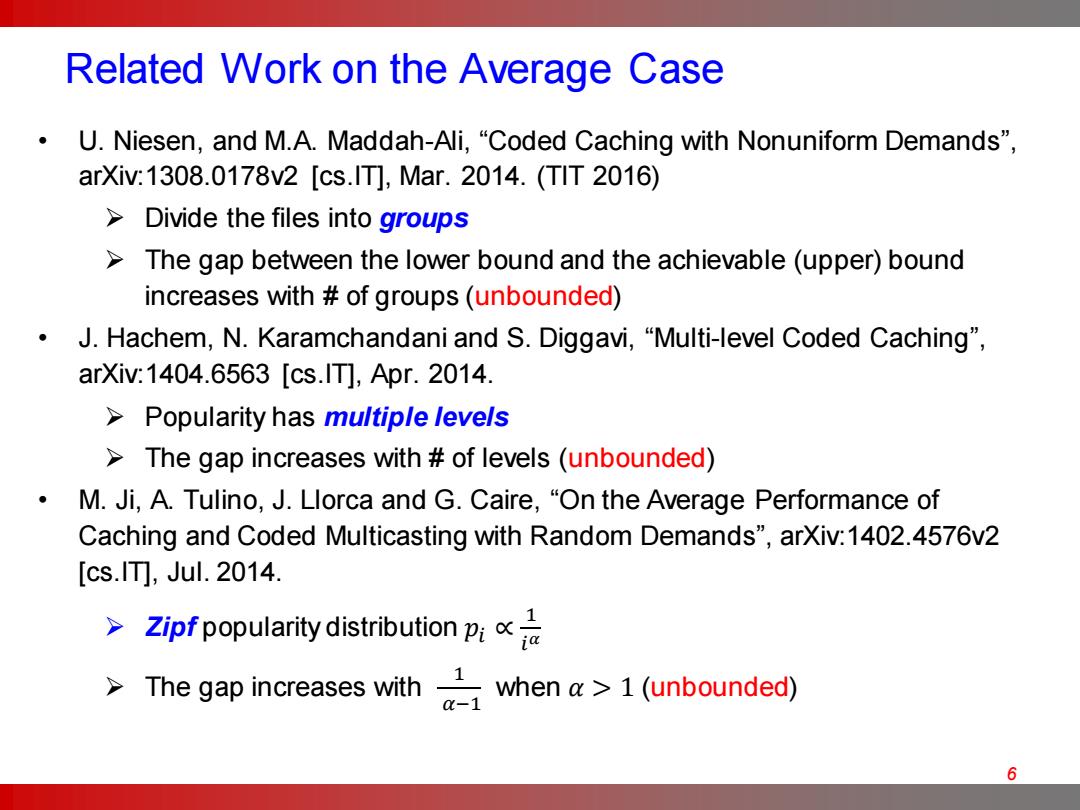
Related Work on the Average Case U.Niesen,and M.A.Maddah-Ali,"Coded Caching with Nonuniform Demands", arXiv:1308.0178v2[cs.T,Mar.2014.(TT2016) >Divide the files into groups The gap between the lower bound and the achievable (upper)bound increases with of groups(unbounded) J.Hachem,N.Karamchandani and S.Diggavi,"Multi-level Coded Caching", arXiv.1404.6563[cs.lT],Apr.2014. Popularity has multiple levels The gap increases with of levels (unbounded) e M.Ji,A.Tulino,J.Llorca and G.Caire,"On the Average Performance of Caching and Coded Multicasting with Random Demands",arXiv:1402.4576v2 [cs.1d,Jul.2014. zipfpopularity distribution The gap increases with when a 1(unbounded) 6
Related Work on the Average Case • U. Niesen, and M.A. Maddah-Ali, “Coded Caching with Nonuniform Demands”, arXiv:1308.0178v2 [cs.IT], Mar. 2014. (TIT 2016) ➢ Divide the files into groups ➢ The gap between the lower bound and the achievable (upper) bound increases with # of groups (unbounded) • J. Hachem, N. Karamchandani and S. Diggavi, “Multi-level Coded Caching”, arXiv:1404.6563 [cs.IT], Apr. 2014. ➢ Popularity has multiple levels ➢ The gap increases with # of levels (unbounded) • M. Ji, A. Tulino, J. Llorca and G. Caire, “On the Average Performance of Caching and Coded Multicasting with Random Demands”, arXiv:1402.4576v2 [cs.IT], Jul. 2014. ➢ Zipf popularity distribution 𝑝𝑖 ∝ 1 𝑖 𝛼 ➢ The gap increases with 1 𝛼−1 when 𝛼 > 1 (unbounded) 6

The Open Question Can we find a coded caching scheme whose average-case performance is at most a constant factor away from the minimum independently of any popularity distributions? 7
The Open Question 7 Can we find a coded caching scheme whose average-case performance is at most a constant factor away from the minimum independently of any popularity distributions?
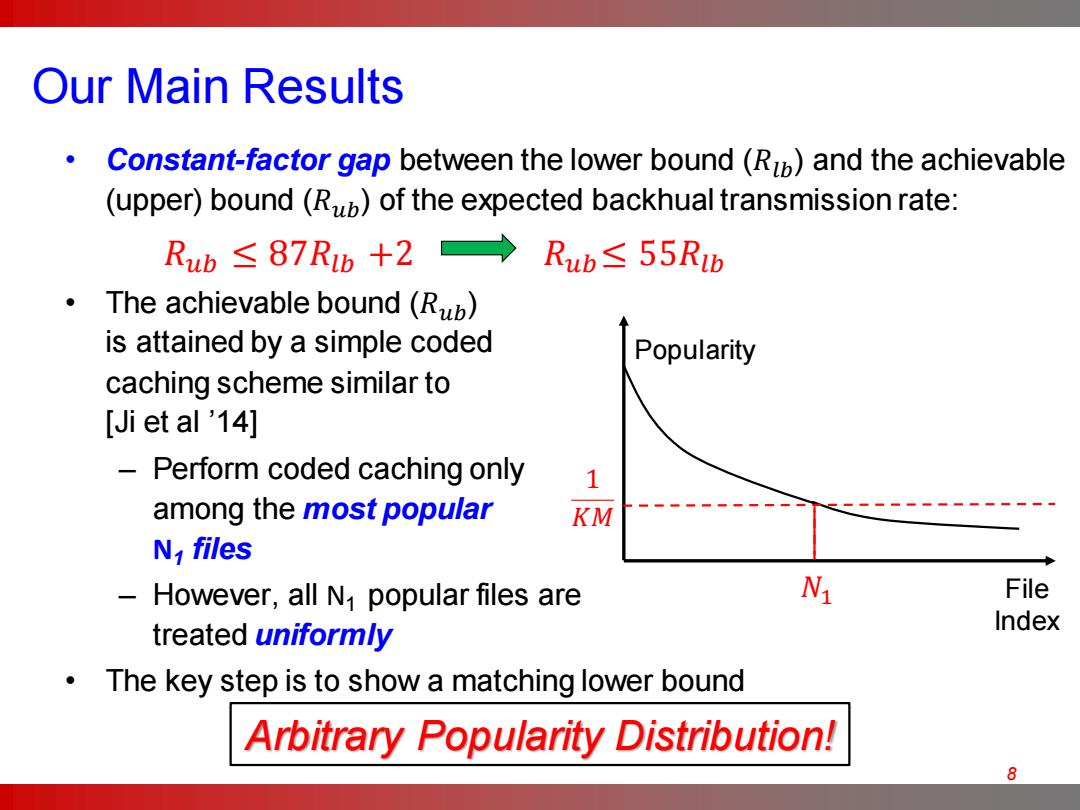
Our Main Results Constant-factor gap between the lower bound(Ru)and the achievable (upper)bound(Rb)of the expected backhual transmission rate: Rub≤87Rb+2→Rub≤55Rb The achievable bound (Rub) is attained by a simple coded Popularity caching scheme similar to [Ji et al '14] Perform coded caching only 1 among the most popular KM N files - However,all N popular files are Ni File treated uniformly Index The key step is to show a matching lower bound Arbitrary Popularity Distribution! 8
Our Main Results • Constant-factor gap between the lower bound (𝑅𝑙𝑏) and the achievable (upper) bound (𝑅𝑢𝑏) of the expected backhual transmission rate: 𝑅𝑢𝑏 ≤ 87𝑅𝑙𝑏 +2 𝑅𝑢𝑏≤ 55𝑅𝑙𝑏 • The achievable bound (𝑅𝑢𝑏 ) is attained by a simple coded caching scheme similar to [Ji et al ’14] – Perform coded caching only among the most popular N1 files – However, all N1 popular files are treated uniformly • The key step is to show a matching lower bound 8 Arbitrary Popularity Distribution! File Index Popularity 1 𝐾𝑀 𝑁1
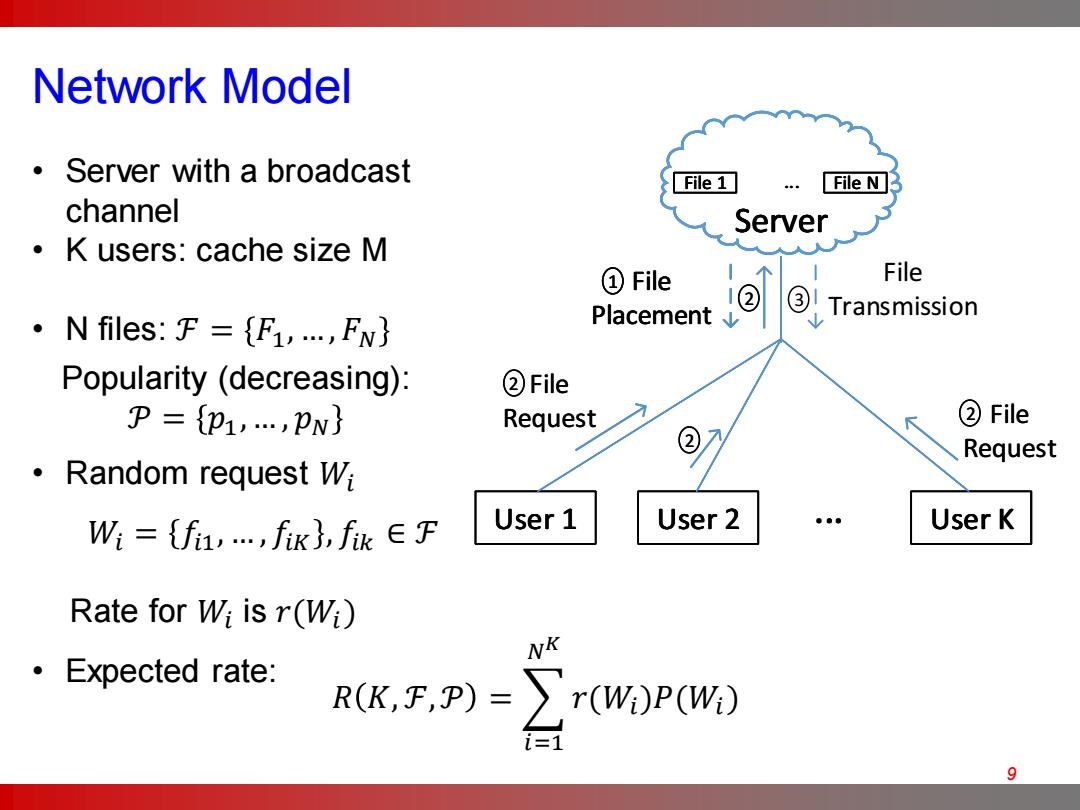
Network Model Server with a broadcast File 1 File N channel Server ·K users:cache size M 人人 ①File File ·N files:F={F,,FN} Transmission Popularity (decreasing): ②File P={p1,,pN} Request ②File 2 Request ·Random request Wi W={fi,,fik},fi欣∈F User 1 User 2 .. User K Rate for Wi is r(Wi) 。Expected rate: R(K,F,P)=>r(Wi)P(W:) i=1 9
Network Model 9 • Server with a broadcast channel • K users: cache size M • N files: ℱ = 𝐹1, …, 𝐹𝑁 • Random request 𝑊𝑖 • Expected rate: Popularity (decreasing): 𝒫 = 𝑝1,… , 𝑝𝑁 𝑊𝑖 = 𝑓𝑖1, … , 𝑓𝑖𝐾 , 𝑓𝑖𝑘 ∈ ℱ Rate for 𝑊𝑖 is 𝑟(𝑊𝑖) 𝑅 𝐾, ℱ,𝒫 = 𝑖=1 𝑁 𝐾 𝑟(𝑊𝑖)𝑃(𝑊𝑖) User 1 File 1 ... File N User 2 ... User K Server File Placement User 1 File 1 ... File N User 2 ... User K 1 Server File Placement User 1 File 1 ... File N User 2 ... User K File Request File Request 1 2 2 2 2 Server File Placement User 1 File 1 ... File N User 2 ... User K File Request File Request File Transmission 1 2 3 2 2 2 Server
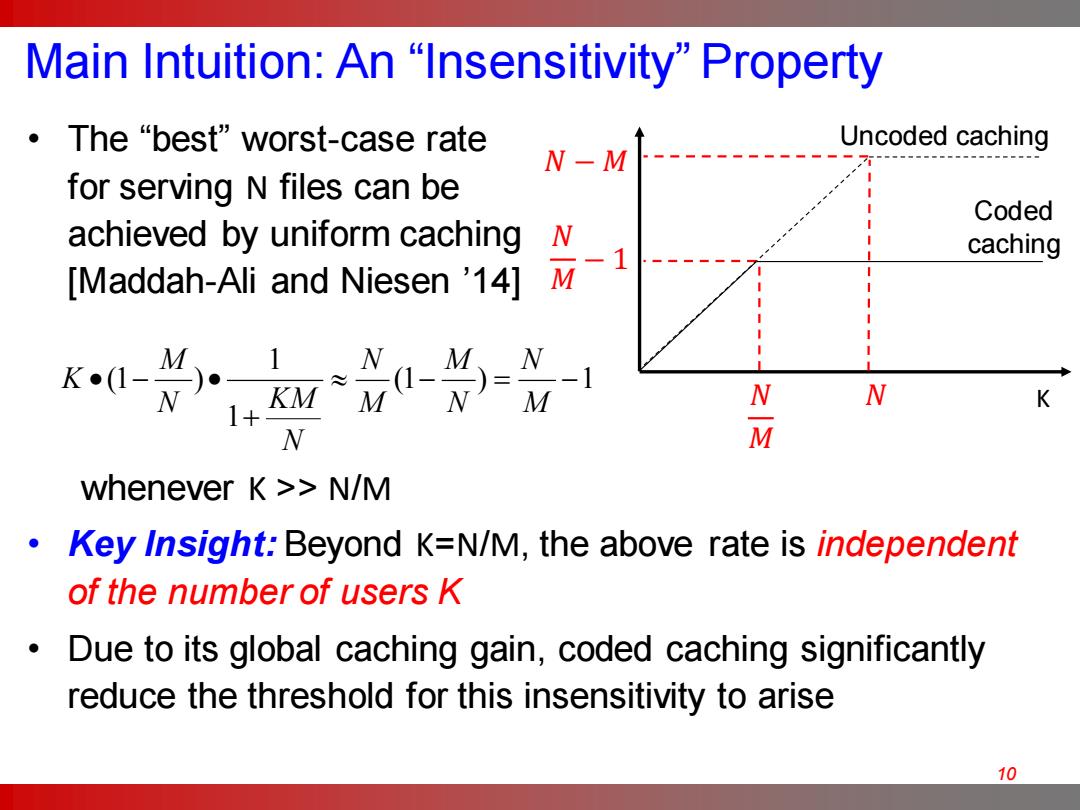
Main Intuition:An "Insensitivity"Property ·The“best”worst-case rate Uncoded caching N-M ”71 for serving N files can be Coded achieved by uniform caching N -1 caching [Maddah-Ali and Niesen '14] M 1 K.(1- M) N M KM 1- M M N N K M whenever K >N/M Key Insight:Beyond K=N/M,the above rate is independent of the number of users K Due to its global caching gain,coded caching significantly reduce the threshold for this insensitivity to arise 10
• The “best” worst-case rate for serving N files can be achieved by uniform caching [Maddah-Ali and Niesen ’14] whenever K >> N/M • Key Insight: Beyond K=N/M, the above rate is independent of the number of users K • Due to its global caching gain, coded caching significantly reduce the threshold for this insensitivity to arise 10 Main Intuition: An “Insensitivity” Property K 𝑁 𝑀 − 1 Coded caching 𝑁 Uncoded caching 𝑁 − 𝑀 𝑁 𝑀 1 (1 ) (1 ) 1 1 M N M N K N M N M KM N • − • − = − +